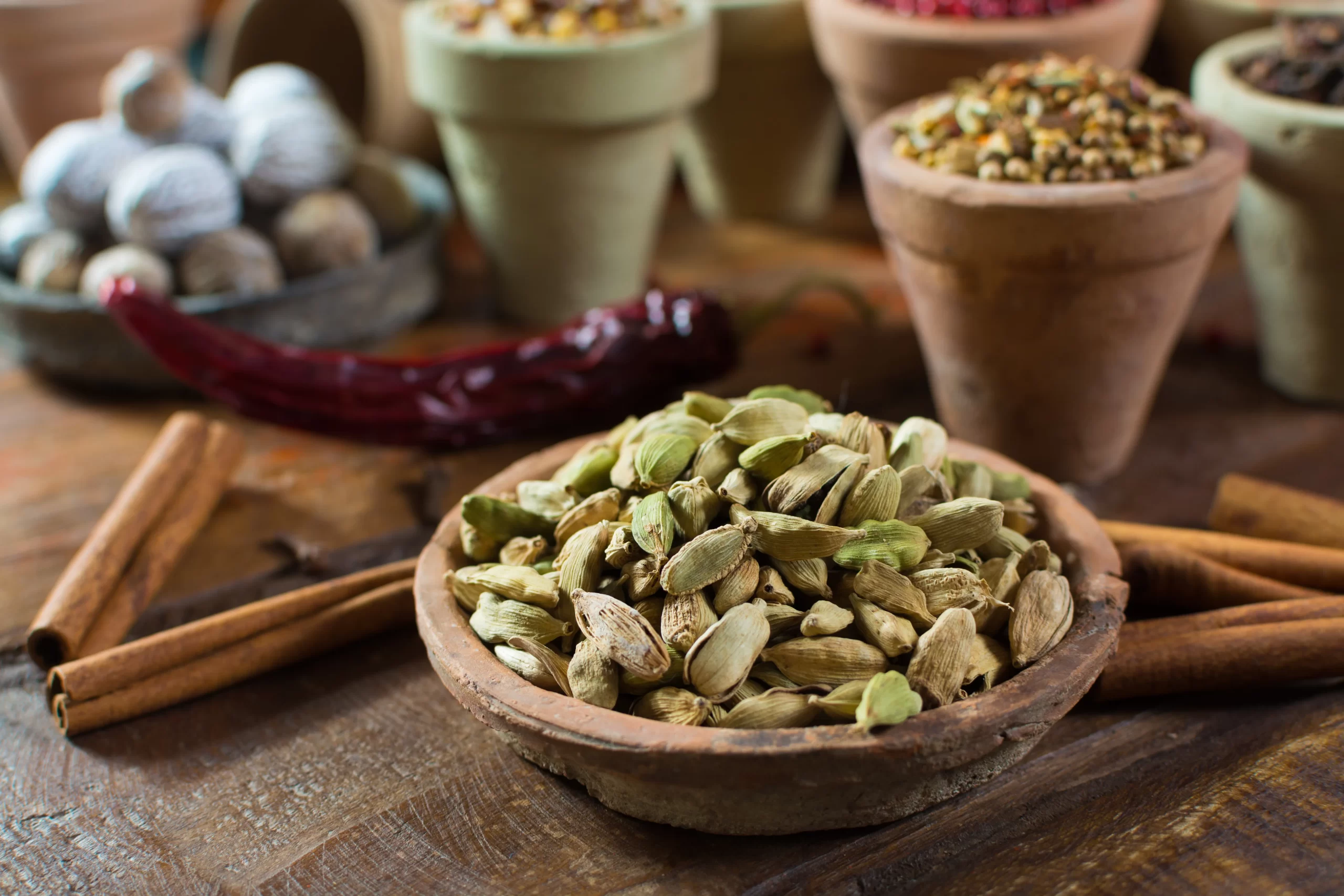The Flavours of Nepal
Kardamom
Green kardamom
A relative of ginger, native to India and Sri Lanka. Green kardamom is very important in Indian and Nepalese, cuisine, but is also used all throughout Asia, and in the Middle East, where it is often infused in coffee. In India and Nepal it is used in the preparation of dairy sweets such as khir (Nepalese rice pudding), but it is also used in savoury dishes such as curry.
Black Kardamom
This variety is different from the green version, but it is a related plant, it is also a legume with seeds, but the seeds of black cardamom are larger. It is used mainly in savoury dishes, such as sauces or marinades. It is not suited to sweet dishes like its green counterpart because it has a stronger flavour and can be a bit smoky.

Cumin
Also known as Egyptian cumin or white cumin, it is a well known spice that is widespread in many countries and has a very long history, having been used in ancient Egypt, and is an essential part of Indian and Nepalese cuisine. In Hungary it is also a common ingredient in the flavouring of various dishes. It is widely used in Middle Eastern cuisines and is of course an important part of Nepalese cuisine.
Fenugreek seed
These brownish-yellow rectangular seeds are an essential spice in Nepali cuisine. It has a strong aroma. It is a very popular spice in the Middle East, and it is also widely used in African and Arab countries. It’s a very hard seed that is difficult to grind, so it is usually heated first, which makes this task easier. It has a very high protein content, has a slightly bitter taste, and is almost always found in curries.
Coriander
Also called Cilantro and Chinese parsley. It adds a penetrating, spicy flavour to dishes. Both the leaves and seeds are used. The leaves are bright green and are used in Asian and South American cuisine. The seeds are usually processed in ground form and are used in both Indian and Nepalese cuisine, but are also common in Southeast Asia.
The leaf gives a strong flavour and is often used to flavour soups and sauces.
The seed is associated with Middle Eastern and Asian cuisines where they combine it with a number of spices with which it harmonises particularly well, like mint and Roman cumin. Coriander seeds are an excellent seasoning for fish dishes, sauces, meats and vegetables. Curries are very often flavoured with it.

Cinnamon
The well-known spice is equally widespread in Nepal and is often used in all kinds of recipes, usually in combination with other spices. It can also be found in five-spice blends.
Clove
It is indigenous to the ’Spice Islands’ and has a very long history, it has already been used in ancient Rome. Around the same time, it crossed over to China as well and most likely got into Nepal throught there.
It is used in both sweet and savoury dishes. It has an amazingly wide range of uses, and is well known in Hungary as well. It can be found in five-spice mixtures.
Bay leaf
It is also a very well-known spice in Hungary, usually found whole in soups, stews and sauces. The Indian bay leaf is a bit different from the one used in Europe. In the Indian bay leaves, there are three veins that run, while in the European one, there is only one. Futhermore, its size is also bigger, and it has a slight cinnamon taste.
Mustardseed
In Nepal, several parts of the mustard plant are used, one of the most important of which is, of course, the mustard seed. It is pressed to extract mustardoil. As a spice, it is commonly used to make various pickles or to flavour curry. But it is also combined with fish to balance the flavour a little. It is an important ingredient in all kinds of pickles and chutneys. It also has many antibacterial properties in addition to its distinctive flavour. There are varieties ranging from yellow to dark brown, the darker the colour, the stronger and more pungent the flavour.
Ghee
In other words, the so-called “clarified butter”. It is made by boiling the butter over a slow fire until all the water evaporates and the protein content precipitates and collects on the top and bottom. The resulting pure milkfat is then filtered and this product is much less likely to spoil than plain butter. It also can be used for baking as it does not foam or burn easily. It also has a subtle sweet taste from the caramelized lactose in it. It has an extremely long shelf life, as slow boiling is a preservation process to get rid of the elements responsible for rancidity. In Nepal, it is usually made from butter made from buffalo or cow milk.
Star anise
An essential ingredient in the Chinese five spice blend, this beautiful herb is native to China, but its use is widespread in neighbouring countries, including Nepal. Its smell is particularly splendid, with a real liquorice flavour.

Nepal
Situated between India and China, Nepal has extremely diverse geographical and climatic features. It is slightly larger than one and a half times that of Hungary and is populated by around 30 million people.

Newari
The fertile soil of the Kathmandu-valley and the trade with Tibet and India brought prosperity. The cross-cultural influences are reflected on the valley’s cuisine, arts and architecture as well.

Magar / Gurung and Gurkha warriors
The Magar and Gurung people live in the hilly region in the western part of Nepal in small communities among the rice paddies. The beautiful panorama of the Annapurna range can be seen from their most famous village, Ghandruk.

Chhettri
The Chhettri were one of the groups of the Khas Hindu community, one of the highest levels of the old caste system. They were the Kshatriya warriors who were the defenders of the system.

Sherpa
The Sherpas are perhaps the best known ethnic group in Nepal. They live high in the mountains of eastern and central Nepal. Originally from Tibet, they crossed the mountains more than 500 years ago.

Tea in Nepal
Tea production in Nepal is relatively young, having only started in the 1960s. Ilam is located in eastern Nepal, about 600 km from Kathmandu.

The Flavours of Nepal
Nepal's flavours are deeply rooted in the country's rich cultural and geographical diversity. The country's cuisine is based on a unique blend of spices such as cardamom, Roman cumin, coriander and fenugreek seeds, which together provide an unforgettable taste experience.

Nepal
Situated between India and China, Nepal has extremely diverse geographical and climatic features.

Newari
The fertile soil of the Kathmandu-valley and the trade with Tibet and India brought prosperity.

Magar / Gurung and Gurkha warriors
The Magar and Gurung people live in the hilly region in the western part of Nepal in small communities among the rice paddies.

Chhettri
The Chhettri were one of the groups of the Khas Hindu community, one of the highest levels of the old caste system.

Sherpa
The Sherpas are perhaps the best known ethnic group in Nepal. They live high in the mountains of eastern and central Nepal.

Tea in Nepal
Tea production in Nepal is relatively young, having only started in the 1960s.

The Flavours of Nepal
Nepal's flavours are deeply rooted in the country's rich cultural and geographical diversity.
Reservation
Új foglalás érkezett!
Opening hours
Monday: CLOSED
Tuesday: 11:30 - 23:00
Wednesday: 11:30 - 23:00
Thursday: 11:30 - 24:00
Friday: 11:30 - 24:00
Saturday: 11:30 - 24:00
Sunday: 11:30 - 23:00
Annapurna Nepáli Étterem
Budapest, Ráday u. 29, 1092
Nyitvatartás
Hétfő: ZÁRVA
Kedd – Szerda: 11:30 – 23:00
Csütörtök – Szombat: 11:30 – 24:00
Vasárnap: 11:30 – 23:00
